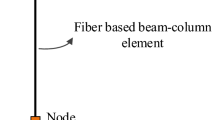Abstract
An analytical model was developed to estimate the shear-strength degradation and the residual capacity of circular reinforced concrete (RC) columns subjected to seismic action. The proposed model is an upgrade of a previously proposed model for axial force \(N\), bending moment \(M\) and shear force \(V\) (\(N\)–\(M\)–\(V\)) interaction domain evaluation for rectangular and circular cross-section RC elements subjected to static loading. The model was extended to the case of circular cross-sections subjected to seismic actions with limitation of the range of variability of the deviation angle between the directions of the stress fields and the crack inclinations, as a function of the amplitude of the flexural ductility demand. Numerical evaluation of resistance domains for circular RC columns having the current structural configuration, like bridge piers, highlights the increment in the risk level induced by shear strength degradation due to flexural ductility demand.






Similar content being viewed by others
References
Ang BG, Priestley MJN, Paulay T (1989) Seismic shear strength of circular reinforced concrete columns. ACI Struct J 86(1):45–59
Architectural Institute of Japan (1994) AIJ structural design guidelines for reinforced concrete buildings. Tokyo
Bach F, Nielsen MP, Braestrup MW (1978) Rational analysis of shear in reinforced concrete beams. In: IABSE proceedings P-17/78, pp 1–16
Bairan Garcia JM, Mari Bernat AR (2006) Coupled model for the non-linear analysis of anisotropic sections subjected to general 3D loading. Part 1: theoretical formulation. Comput Struct 84(31–32):2254–2263
Bertagnoli G, Mancini G, Recupero A, Spinella N (2011) Rotating compression field model for reinforced concrete beams under prevalent shear actions. Struct Concr 12(3):178–186
CEB-FIP (1993) Model code for concrete structures for buildings. Comitè Eurointernational du Bèton, Lausanne
Colajanni P, La Mendola L, Priolo S, Spinella N (2008a) Experimental tests and FEM model for SFRC beams under flexural and shear loads. 2008 seismic engineering international conference commemorating the 1908 Messina and Reggio Calabria earthquake, MERCEA 2008, vol 1020, no 1. Reggio Calabria, Italy, pp 872–879, 8–11 July 2008
Colajanni P., Recupero A., Spinella N. (2008b) Shear strength prediction by modified plasticity theory for SFRC beams. In: 2008 seismic engineering international conference commemorating the 1908 Messina and Reggio Calabria earthquake, MERCEA 2008, vol 1020, no 1. Reggio Calabria, Italy, pp 888–895, 8–11 July 2008
Colajanni P, Recupero A, Spinella N (2012) Generalization of shear truss model to the case of SFRC beams with stirrups. Comput Concr 9(3):227–244
Colajanni P, Recupero A, Spinella N (2014) Design procedure for prestressed concrete beams. Comput Concr 13(2):235–253
Cucchiara C, Fossetti M, Papia M (2012) Steel fibre and transverse reinforcement effects on the behaviour of high strength concrete beams. Struct Eng Mech 42(4):551–570
Eurocode No. 2 (1992) Design of concrete structures: Part. 1: General rules and rules for buildings. UNI ENV 1992-1-1
Martin-Pérez B, Pantazopoulou SJ (1998) Mechanics of concrete participation in cyclic shear resistance of reinforced concrete. ASCE J Struct Eng 124(6):633–641
Martin-Pérez B, Pantazopoulou SJ (2001) Effect of bond, aggregate interlock and dowel action on the shear strength degradation of reinforced concrete. Eng Struct 23:214–227
Park YJ, Ang AHS (1985) Mechanistic seismic damage model for reinforced concrete. J Struct Eng ASCE 111(4):722–739
Priestley MJN, Benzoni G (1996) Seismic performance of circular columns with low longitudinal reinforcement ratios. ACI Struct J 93(4):474–485
Recupero A, D’Aveni A, Ghersi A (2003) N-M-V interaction domains for box I-shaped reinforced concrete members. ACI Struct J 100(1):113–119
Recupero A, D’Aveni A, Ghersi A (2005) M-V interaction domains for prestressed concrete beams. ASCE J Struct Eng 131(9):1413–1421
Rossi PP, Recupero A (2013) Ultimate strength of reinforced concrete circular members subjected to axial force, bending moment and shear force. ASCE J Struct Eng 139(6):915–928
Schwartz J (2002) Stress field design of reinforced concrete members with circular cross sections. Struct Eng Int 12(1):36–39
Spinella N, Colajanni P, La Mendola L (2012) Nonlinear analysis of beams reinforced in shear with stirrups and steel fibers. ACI Struct J 109(1):53–64
Spinella N, Colajanni P, Recupero A (2010) Simple plastic model for shear critical SFRC beams. ASCE J Struct Eng 136(4):390–400
Spinella N (2013) Shear strength of full-scale steel fibre-reinforced concrete beams without stirrups. Comput Concr 11(5):365–382
Turmo J, Ramos G, Aparicio AC (2009) Shear truss analogy for concrete members of solid and hollow circular cross section. Eng Struct 31(2):455–465
Vecchio FJ, Collins MP (1986) The modified compression field theory for reinforced concrete elements subjected to shear. ACI Struct J 83(2):59–61
Watanabe F, Ichinose T (1991) Strength and ductility design of RC members subjected to combined bending and shear. Concrete shear in earthquakes. University of Houston, Houston
Acknowledgments
This work was carried out within the 2014–2017 Research Project “DPC–ReLUIS (Dipartimento Protezione Civile—Rete dei Laboratori Universitari di Ingegneria Sismica)”, Linea di Ricerca—Cemento Armato. The related financial support was greatly appreciated.
Author information
Authors and Affiliations
Corresponding author
Rights and permissions
About this article
Cite this article
Colajanni, P., Recupero, A. & Spinella, N. Shear strength degradation due to flexural ductility demand in circular RC columns. Bull Earthquake Eng 13, 1795–1807 (2015). https://doi.org/10.1007/s10518-014-9691-0
Received:
Accepted:
Published:
Issue Date:
DOI: https://doi.org/10.1007/s10518-014-9691-0




